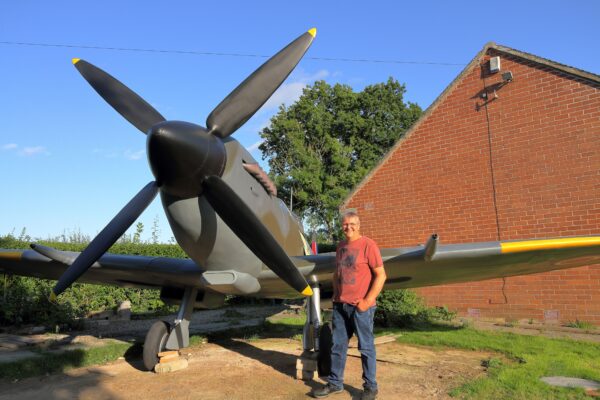Exclusive Interview with Author David Price
David tells his story of creating a full-sized World War II RAF Spitfire fighter plane in his garden.

Lots of people enjoy making models – but creating a full-sized World War II RAF Spitfire fighter plane in your garden is taking things to a whole new level. But that’s what David Price did. Ahead of his visit to Wigtown Book Festival we asked him to tell us about how the initial idea went from flight of fancy to fabulous reality.
Everyone loves a Spitfire. It may be a generalisation, but I have not met many people who dislike this icon of 1930s engineering. What is it about the form and performance of this superlative Second World War fighter that so attracts us?
It is a question I have tussled with for many years as an aviation enthusiast and writer. My appreciation started as a child and Airfix helped me understand more of the aircraft. I was like so many of my generation who built models and re-lived the dogfights in imaginary skies where the victor was always the Spitfire. When I was older I visited airshows and watched in wonder as the graceful Spitfire captured hearts and stirred emotions. That should have been the extent of my journey.
My first thought was that the Spitfire was small...
However, standing at the cliff-top Battle of Britain Memorial at Capel-le-Fern Folkstone in 2018, I had a moment of epiphany. Their fibreglass Spitfire reproduction had caught my eye and imagination. I had seen many Spitfires over the years, both flying and on the ground but suddenly I had two thoughts that converged in surprising fashion. The first thought was that the Spitfire was small – a size that would fit into my modest garden, and the second was that with a good set of plans I could build something as good. For most, such thoughts might be dismissed as a spark of whimsey, but in the weeks following I found myself embarking on the biggest project of my life. Building the Spitfire, albeit in wood and fibreglass rather than aluminium, devoured my waking hours and dominated my slumber. Writing the book about this adventure, ‘How to Build a Spitfire’ took less time but it also gave me the opportunity to tell the story of how real Spitfires were conceived and created.
An Outstanding Contribution to Conflict
For many, the Spitfire is the aircraft that saved us from invasion in the Battle of Britain and went on to help us win the war. Although the Spitfire played an outstanding contribution in the conflict, it was not the very best aircraft of the era. In the rapid battle of technologies, other newer aircraft designs leap-frogged the performance of the Spitfire – but it always evolved and improved to be a match for any foe. It was not until the appearance of the jet towards the end of the war that it was realised that no further power could be squeezed from propeller engines. The era of the Spitfire was closing – or so it was thought.
As strong as the Spitfire’s performance was, it is the aesthetics of the aircraft that seems to captivate the viewer. In the myth of the creation of the Spitfire, it seamlessly developed out of the Supermarine S6 floatplane that won the Scheider Air race of 1931. The truth is that the fighter that Supermarine were commissioned to build, the Type 224, was a disaster. It performed badly, it was unreliable, and to add insult to injury, it was ungainly with a large fixed undercarriage and “gull” wings. Chief designer RJ Mitchell came to the rescue by effectively drawing lines through the plans of the Type 224 and redesigning the aircraft into what we know and love so well – the beautiful Spitfire. Mitchell was an ill man and he did not live to see his aircraft perform in battle, but we owe him an enormous debt of gratitude.
The Real Star is the Aeroplane
My full-sized reproduction was not built to fly but it still drew dozens of misty-eyed visitors who stood in wonder in my garden, captivated by the shape and the wider story of the Spitfire. Although the spectacle of one man undertaking this massive project won admirers, I believe the real star is the aeroplane and all it stands for in our psyche. It is now safely tucked away out of the Cumbrian weather in a museum and instead of working tirelessly on it, I now mow the lawn and shuffle around the garden like a “normal” person.
Why did I do it? To be honest, I’m still not entirely sure.
You can purchase tickets for David Price's event via our website.
The PDF of the 2025 Wigtown Book Festival programme can be downloaded here, or book your tickets online.